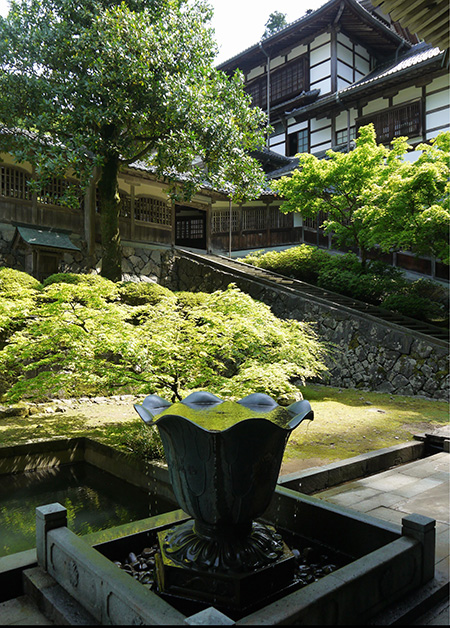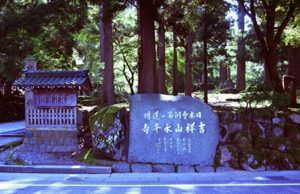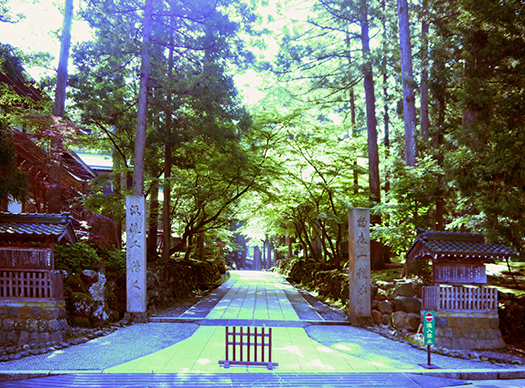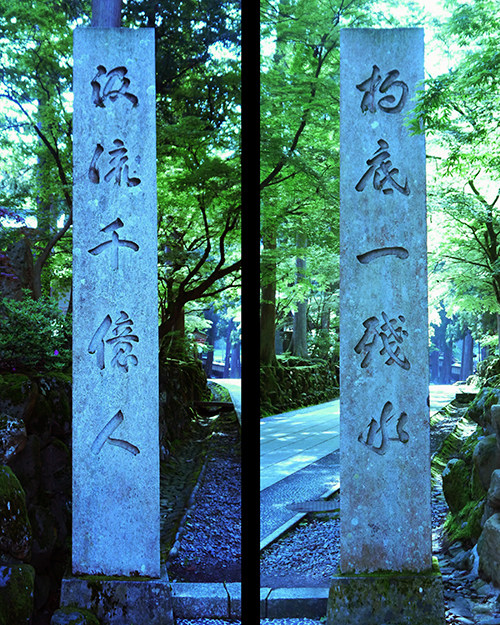


さてふたたび仏教寺院建築探訪シリーズ復帰です。
どうも現世では独裁強権国家の無道が世界に波及し続けていて辟易する。
感染症についての世界の悲惨な状況を見るに付け無常感が募る。
そういう気分を少しでも回避するのにも、日本の仏教文化に興味が向かう・・・。
ということで韓国仏国寺参観体験を一種の対比コンパスに使って
日本への仏教導入の流れに沿って見てきています。
日本人の住宅、広く建築技術発展は歴史的に宗教建築のありように
ある程度反映されてきている部分があるのも事実。
そういった痕跡も確認できて興味が増しています。
飛鳥寺、四天王寺、法隆寺の最初期から高野山金剛峯寺。そして
そこから中世にかけての根来寺と見てきました。
畿内地域で展開した王朝国家体制での仏教のありようと、
その展開を見てきたけれど、日本史はその後の武家支配期を迎える。
武家の都として京都とは離れて東国に開かれた鎌倉には「建長寺」という
元号を寺号にした国家寺院として禅の宗派が初源した。
そういう流れに即して曹洞宗の「日本第一道場」としての永平寺探訪です。
禅宗には3つの流派があり、それらの共同の意見として「禅宗」と
ひとくくりにはしないでというアピールがあるそうです。
とはいえ、衆生としては他との相違も知りたいので区分けはしておきたい。
鎌倉で武権が成立し「大仏」が建立され建長寺が建てられたことは
この国の政治にとっても重要だったでしょう。
それまでの日本が導入してきた宗教政策とはあきらかに変化させている。
源平争乱のひとつの大きな災禍として奈良東大寺の焼失があり
勧進元重源さんの旺盛な活動があって、復興が達成されたとき、
重要な役割を頼朝政権は果たしていたとされ、戦乱の時代空気感のなかで、
復興の記念イベントには頼朝自身が参列したと言われる。
さながら戒厳令のような緊張感が世を覆っていたという記録もある。
最高権力者となった頼朝は、世の統治にあたって、
宗教文化に対してその価値を知りながら相応の対応を見せていることがわかる。
そしてその流れの表現として建長寺での禅の採用があったように思う。
1253年と幕府は成立からすでに50-60年時間を経過しているけれど
大きく「武家政権」のありようを示すものとして禅は採用され公示された。
・・・そんな意味も込めながら探ってみたいと思います。

永平寺の入口には石柱が左右に一対立っている。
杓底一残水
汲流千億人
「杓底の一残水(しゃくていいちざんすい)、流れを汲む千億の人」
というように読み下されるとのことで、大意としては、
道元禅師が教えられそして古人が歩んだ道(教え)は人の心の垢を除き去る。
柄杓で汲んだ水で手を洗い底に残った水を川へ還された。
そうした道元禅師の風を慕い多くの人が永平寺の門をくぐってその教えを汲む。
永平寺の境内には川が豊富に流れ絶えることがない。
かつて食べ物が十分になかった頃でも、水が不足することはなかった。
そのいくらでもある水さえ粗末にしてはいけない、大切にするようにと、
道元禅師は教えられた〜という意味だと、訪問後知りました。
いきなりの「禅問答」から探訪は始まります(笑)・・・。
English version⬇
[Inner world view spreading in the world of samurai Eiheiji-1]
Now, it is the return of the Buddhist temple architecture exploration series again.
Apparently, in this world, the ruthlessness of a dictatorship nation continues to spread to the world, and it makes me sick.
Seeing the dire situation in the world about infectious diseases creates a sense of impermanence.
To avoid such a mood, I am interested in Japanese Buddhist culture.
So, using the experience of visiting the Korean Bulguksa Temple as a kind of contrasting compass
I have been watching along the flow of introducing Buddhism to Japan.
Japanese housing, the development of building technology is historically like religious architecture
It is also true that some parts have been reflected to some extent.
I can see such traces and I am getting more interested.
Koyasan Kongobuji Temple from the earliest days of Asuka Temple, Shitennoji Temple, and Horyu-ji Temple. and
I saw it as Negoroji from there to the Middle Ages.
Whatever Buddhism should be in the dynasty state system developed in the Kinai region,
I have seen the development, but Japanese history will enter the samurai rule period after that.
Kenchoji is located in Kamakura, which was opened in the eastern part of Kyoto as the capital of the samurai family.
The Zen sect was the first to originate as a national temple with the era name as the temple name.
In line with this trend, we visited Eiheiji Temple as the “Japan’s First Dojo” of the Soto sect.
There are three schools of Zen Buddhism, and the common opinion of them is “Zen Buddhism”.
It seems that there is an appeal that you should not put it all together.
However, as sentient beings, I would like to know the differences from others, so I would like to classify them.
The fact that the military power was established in Kamakura, the “Big Buddha” was erected, and the Kenchoji Temple was built
It would have been important for the politics of this country.
It is clearly changing the religious policy that Japan has introduced up to that point.
One of the major disasters of the Genpei War was the burning of Todaiji Temple in Nara.
When the reconstruction was achieved due to the vigorous activities of Kanjin Chogen
It is said that the Yoritomo administration played an important role, and in the atmosphere of the wartime era,
It is said that Yoritomo himself attended the reconstruction commemorative event.
There is also a record that tension like martial law was overwhelming the world.
Yoritomo, who became the most powerful person, was in charge of governing the world.
It turns out that he is responding appropriately to religious culture, knowing its value.
And I think that Zen was adopted at Kenchoji as an expression of that flow.
Although it has already been 50-60 years since the establishment of the Shogunate in 1253.
Zen was adopted and announced as a major indicator of what the “samurai government” should be.
… I would like to explore it with such a meaning.
At the entrance of Eiheiji Temple, a pair of stone pillars stands on the left and right.
One cassotte residual water
100 billion people
“One cassotte residual water, 100 billion people who draw the flow”
It is said that it will be read down like this, so the main point is
The path (teaching) that Dogen Zenshi was taught and the old man walked removes the dirt of the human heart.
I washed my hands with the water drawn with a cassotte and returned the water left on the bottom to the river.
Many people long for the wind of Dogen Zenshi and go through the gate of Eiheiji Temple to learn the teachings.
Abundant rivers flow in the precincts of Eiheiji Temple and never cease.
Even when there wasn’t enough food in the past, there was no shortage of water.
Don’t let that amount of water be poor, take good care of it,
After visiting, I learned that Dogen Zenshi meant that he was taught.
The exploration begins with a sudden “Zen question and answer” (laughs).
Posted on 11月 28th, 2021 by 三木 奎吾
Filed under: 住宅マーケティング, 日本社会・文化研究







コメントを投稿
「※誹謗中傷や、悪意のある書き込み、営利目的などのコメントを防ぐために、投稿された全てのコメントは一時的に保留されますのでご了承ください。」
You must be logged in to post a comment.